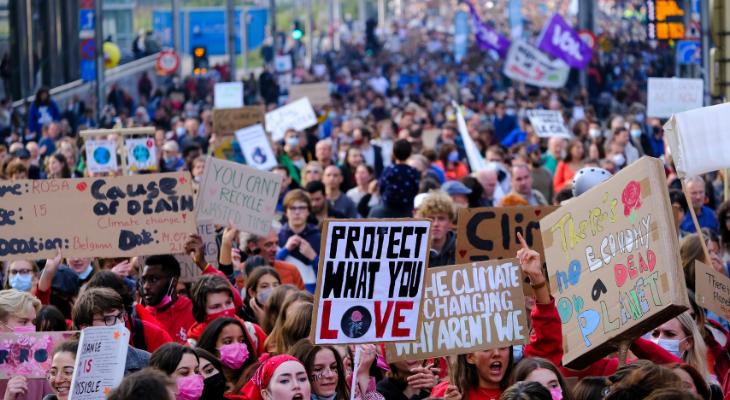A ‘Crucial Test’ for Faith Communities: COP26 and the Road Ahead
December 17, 2021

One day last summer I put some hot coals from burning frankincense and oud (aloeswood) into a pot of soil that housed an aloe plant. I thought the soil would put the fire out. It did not. The aloe plant was a gift from my good friend — a master farmer — and the soil was intentionally crafted to be the perfect environment for the aloe to grow and flourish. In this case the soil was quite dry and the embers that were inside the coals smoldered in the pot without me knowing. I went about the house doing various chores until the smoke from the fire touched my nose. Initially I shrugged it off. I came back to the pot twice to douse it with water, but the smell of woods, of earth, of life burning remained faint but clear.
I had to act. Finally, I filled a large Mason jar with cold water and thoroughly and definitively put the fire out. It was time to act.
This is where we are right now. The fire has long been smoldering. We have tried some things to put it out, but those attempts have been half-hearted at best. Ultimately, as is the assessment of the recent international gathering of Conference of the Parties of COP26 in Glasgow, there needs to be a sense of urgency to put out this fire of climate change. This sentiment was heard in the streets, from “the people” in attendance and from the formal attendees who sat in the chairs and who were charged to make an agreement.
The world is running towards the fire and we know that we need to put it out. But do we have the right tools in place to do so? I use my faith, Islam, to guide my actions and find community in fellowship not just with other Muslims but with all believers who are committed to a path. What is the role of the faith-based community in helping stop catastrophic climate change? Right now, each nation needs to “take stock” of the agreements made in Glasgow. For those of us who follow a spiritual path, we too must identify specific actions that we will take individually, as religious communities and congregations, and what specific actions and policies we will expect the institutions we are part of will – and must – take.
Taking Stock
Let’s take a step back for a minute to 1972 and an event called the Conference on the Human Environment. I recently talked to one of my heroes in this work named Denis Hayes — founder of the first Earth Day and a true visionary leader in regenerative building design. He was there.
“I was a member of the advisory committee to the (United States) Secretary of State for the conference,” Hayes said. He continued, “It was arguably the great granddaddy of Rio, Paris, Copenhagen, Montreal, Glasgow.”
Ok, this tells me that we have known that the fire has been burning for a long time! It is clear, international agreements on anything are hard!
Hayes: “The environment, as a coherent field of policy and politics was brand new… dominated as you might expect in the Nixon years, by business interests.”
Yes, it is true. The beginnings of the environmental movement, as led by government, as we understand today in the United States, were initiated by a Republican administration and at its heart understood the link between not only human activity and pollution but also economic activity.
The Path from Montreal to Glasgow: From the fringes to global priority
But what does COP26 even mean? COP26 is the 2021 United Nations Climate Change Conference. COP stands for “Conference of the Parties.”
Since the 1987 establishment of the Intergovernmental Panel on Climate Change, the focus has been on organizing a coordinated response to the erosion of the ozone layer. I recall those conversations vividly and was in middle school at the time. We understood that certain products were effectively harming the thin layer of atmosphere that essentially protected us from harmful radiation. Coming out of that era came the Montreal Protocol, which established a fund for giving up the harmful CFCs that we were using in many products and which was causing the harm.
“Work on ozone depletion would have happened with or without The Montreal Protocol,” which banned the use of CFCs altogether in industrialized countries by the year 2000, Hayes says, “because the issue jumped on to the front pages.” Hayes is careful to somewhat cynically note, ”Of course, maybe, most importantly, the manufacturers of CFCs were the same entities that would manufacture the (closely-related) replacements for CFCs.”
Hayes adds, “The Dows and DuPonts of the world did not fight the change tooth and nail, the way oil, gas, and coal spent decades lying about solar, wind, batteries, etc.”
Two takeaways from the agreements on ozone depletion are that private entities, when they see it in their overall economic interest, would be more than willing to change their actions that are harmful to the planet but also that they aren’t the only important sector. Given detrimental ecological impacts the role of governments to provide the ideal response is crucial.
Rio’s 1992 Framework Convention on Climate Change essentially enshrined in international law that richer nations have a greater responsibility for the climate changing. It seems like a no-brainer. In the context of the United States Environmental Protection Agency’s s “Superfund” program, areas that have large amounts of pollution from long-term industrial activity – places where gas was manufactured, for example – the companies that ran and made money from those industries are called “Responsible Parties” and must pay for the clean-up of the Superfund. At the international level, Rio put forward a version of this. The concept is called “CBDR,” which stands for Common But Differentiated Responsibility. Countries that have the largest and most polluting industries bear a greater responsibility for climate change – and for addressing it.
1997’s groundbreaking Kyoto Protocol was celebrated at the time. Climate negotiators developed an emissions trading feature. This facilitated emissions trading at the domestic level. Kyoto established that countries agreed to reduce greenhouse gas emissions – which have led to catastrophic climate change.
2009’s Copenhagen is roundly considered a failure. The Guardian newspaper noted at that time, “The Copenhagen meeting was a disappointment, primarily because it failed to set the basic targets for reducing global annual emissions of greenhouse gases from now up to 2050 and did not secure commitments from countries to meet these targets collectively.”
As you can see, climate change has essentially gone from the fringes to being a global priority.
Spiritual leaders at COP26
I spoke with the Rev. Mariama White-Hammond, city of Boston’s Chief of Environment, Energy, and Open Space. She is the founding pastor of New Roots AME Church in Dorchester, a multi-racial, multi-class community, and in her role for the city of Boston she is responsible for protecting air, water, climate, and land resources, as well as preserving Boston’s built environment. She attended the most recent Conference of the Parties or COP26. She found herself in rooms with young people and organizers in the streets as well as with corporate executives from fossil fuel burning companies.
“[It was] very interesting being there as a spiritual leader. I think about it from a larger spiritual and moral perspective.” White-Hammond described her role there as “Lovingly calling people out.” White Hammond says, “I fight for my people on issues that have nothing to do with climate change.”
The Rev. Frederick Davie, a Presbyterian minister in New York City and IFYC Senior Advisor for Racial Equity Programs who has held many leadership positions in academia, the faith world, and in politics, was also in attendance. He noted the difference between the organizing happening in the streets, mainly with nongovernmental organizations, and the formal conference attendees.
One New York Times headline summed it up, “Young Women Are Leading Climate Protests. Guess Who Runs Global Talks?”
AtmosMag noted, “The first draft of the decisions document to come out of COP26 contains zero mention of phasing out fossil fuels. If the negotiations don’t successfully limit global temperature rise to 1.5°C, leaders will be signing a death sentence for some countries, not a climate agreement.”
Artist and climate activist Favianna Rodriguez noted that despite the glaring inequities on display, as realized by the heavy presence of fossil fuel companies and the omission of specifically phasing out fossil fuels, “one huge source of inspiration here at COP26 is the clarity of vision of young BIPOC (Black, Indigenous, People of Color) activists. I am in awe at their sharp analysis and courage to call out polluters!”
So where are we? This period is a time for global communities to “take stock” of the agreement and determine what national commitments and actions can and should be. What will the United States commit to?
Share
Related Articles
American Civic Life
Racial Equity
Immigrant Faith Communities On Rooting Out Anti-Black Racism
American Civic Life
And what will people of faith do?
And what will people of faith do?
“I suspect that for most in the Black Christian experience climate is not a primary concern,” Davie lamented, “Work needs to be done.”
What that “work” looks like for people of faith is what I am most curious about.
For the faith community this is a crucial test. Faith holds itself to be a constant, a mirror on the wall that tells us time and time again how similar we are to the people of the past, how we might fall for the same tricks – and therefore could be heading for a tragic fall. Faith and faith stories give us premonitions, warnings, and reminders in story and scripture. The test for faith communities is quite existential because the stakes are really at that “biblical” scale.
Of course, communities of faith have been at each of these gatherings. How did and will faith leaders “show up”? What is our role? Will we be a force that moves the conversation forward or will we be stuck in the dichotomy that has prevented meaningful action from taking place?
Considering my smoldering aloe plant story, and taking stock of the agreements of COP26, will faith communities bring water, or add fuel, to the fire?
Ibrahim Abdul-Matin is the author of “Green Deen: What Islam Teaches About Protecting the Planet” and is the co-founder of Green Squash Consulting, a management consulting firm based in New York that works with people, organizations, companies, coalitions and governments committed to equity and justice and specializes in dynamic strategic and focused stakeholder management and partnership development. He sits on the boards of the International Living Future Institute encouraging the creation of a regenerative built environment and Sapelo Square whose mission is to celebrate and analyze the experiences of Black Muslims in the United States.



